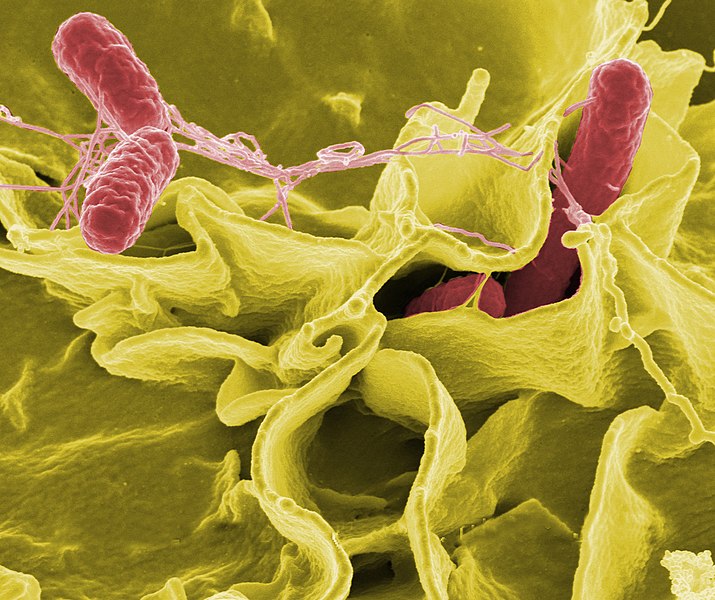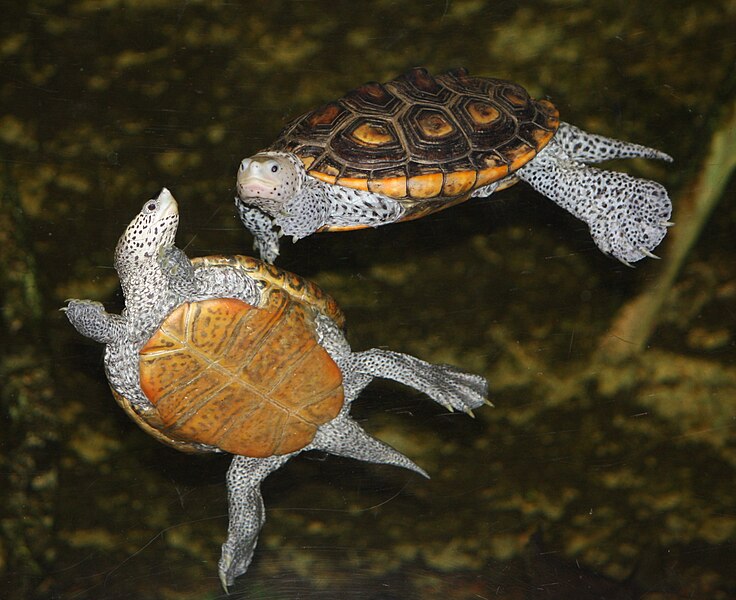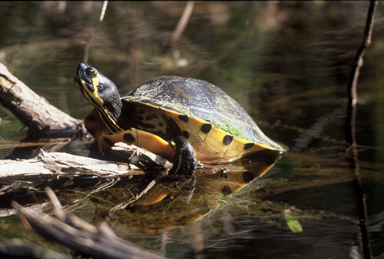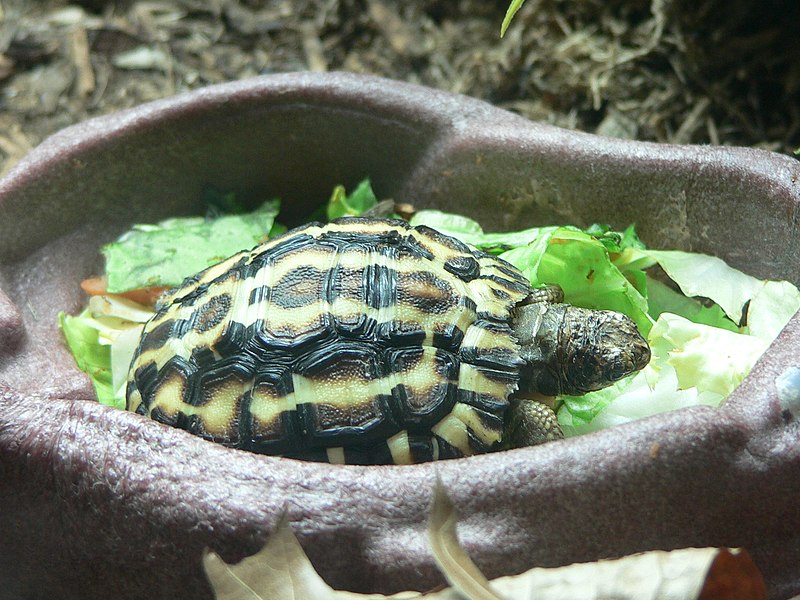 Tortoises are highly prized by reptile fans. They are extremely responsive, quickly recognizing those who feed them, and readily learn from experience. Unfortunately, new owners are often unaware of their very specific care requirements, and many fail to thrive. Given the precarious state of their wild populations, it is unethical to keep these amazing animals unless you are fully prepared to meet their needs. Please write in for further guidance.
Tortoises are highly prized by reptile fans. They are extremely responsive, quickly recognizing those who feed them, and readily learn from experience. Unfortunately, new owners are often unaware of their very specific care requirements, and many fail to thrive. Given the precarious state of their wild populations, it is unethical to keep these amazing animals unless you are fully prepared to meet their needs. Please write in for further guidance.
The Bronx Zoo’s collection was very “tortoise/turtle oriented” during my tenure, and I had the good fortune to work with dozens of species both there and in the field. From rare Flat-Tailed (Pyxis planicauda) and tiny Egyptian Tortoises (Testudo kleinmanni) to 500 pound Aldabra and Galapagos Tortoises, each brought challenges and new lessons. Hopefully, what I’ve learned will be of benefit to other keepers, and to the spectacular animals in which they are interested.
The following information can be applied to the care of a variety of species. However, details will vary; please write in for information on individual species.
Natural History
Fifty-three tortoise species roam the grasslands, deserts and tropical forests of Africa (where they reach their greatest diversity) North and South America, Europe, and Asia.
All tortoises live on land and feed mainly on vegetation. They range in size from the 4-inch-long Speckled Padloper (Homopus signatus) to the 500+ pound Aldabra and Galapagos Tortoises.
Housing
Setting up the Terrarium
Tortoises need far more room than most folks imagine. Only the smallest, such as Spectacled and Russian Tortoises, can be accommodated in commercial cages. Adults generally do best in enclosures that have been constructed with their needs in mind.
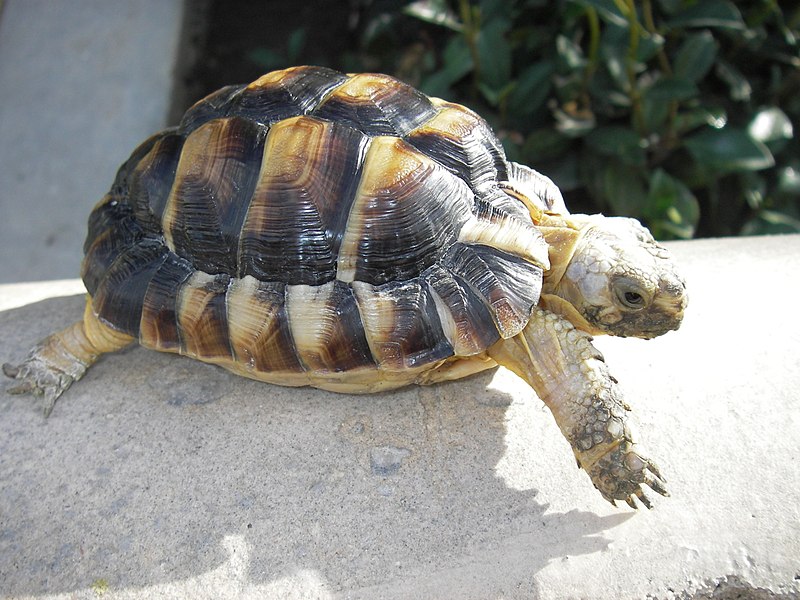
Outdoor maintenance is possible in suitable climates. Please write in for details.
Plastic-based rabbit cages are preferable to aquariums, but most tortoises will outgrow these in time. Cattle troughs can also be modified as tortoise homes.
This Table Top Tortoise Terrarium is an ideal enclosure for many species. The Zoo Med Tortoise Home can be expanded with additional units, and is well-worth investigating.
Substrate
“Playground” sand is suitable for Radiated, Leopard and other tortoises native to arid environments. An equal amount of sand and topsoil can be used for Yellow-Footed Tortoises and other forest dwellers.
Although impactions due to swallowed sand and soil are rare, it is best to provide food in large bowls so that ingestion is limited.
The substrate should be deep enough to allow your tortoise to dig a shallow pallet (sleeping depression) at night. Dry grass clumps can also be provided as shelter.
Light
Tortoises need daily exposure to high levels of UVB light. Natural sunlight is best, but be aware that glass and plastic filter out UVB rays, and that fatal overheating can occur very quickly.
Use a high-output UVB bulb (the Zoo Med 10.0 Bulb is ideal), and position the basking site within 6-12 inches of it.Mercury vapor and halogen bulbs broadcast UVB over greater distances, and provide beneficial UVA radiation as well.
Heat
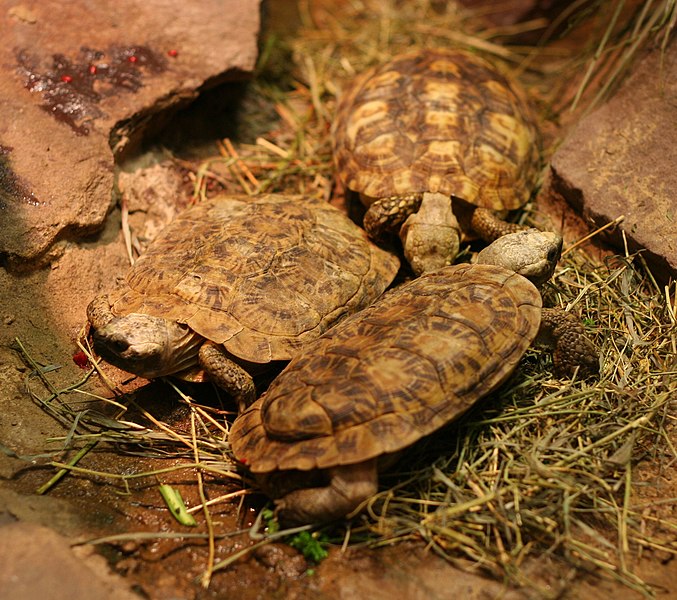 Most tortoises require a basking site of 90-95 F, but must be able to move into cooler areas (75-88 F) as well. Incandescent heat bulbs should be used to maintain these temperatures; red/black night bulbs or ceramic heater-emitters work well after dark.
Most tortoises require a basking site of 90-95 F, but must be able to move into cooler areas (75-88 F) as well. Incandescent heat bulbs should be used to maintain these temperatures; red/black night bulbs or ceramic heater-emitters work well after dark.
Humidity
Desert and grassland tortoises develop health problems in damp enclosures, but low humidity has been associated with growth abnormalities in several species. Please write in for details.
Travancore Tortoises and other forest-dwellers need access to moist and dry areas.
Companions
Females and youngsters often co-exist, but must be watched as dominance hierarchies will develop. Males will fight, and often harass females with near-constant mating attempts.
Feeding
A great deal of conflicting information has been published on the subject of nutrition, and confusion concerning this critical aspect of tortoise husbandry is common. Unfortunately, small dietary mistakes will translate into major health concerns in short order.
Grassland and Desert Tortoises
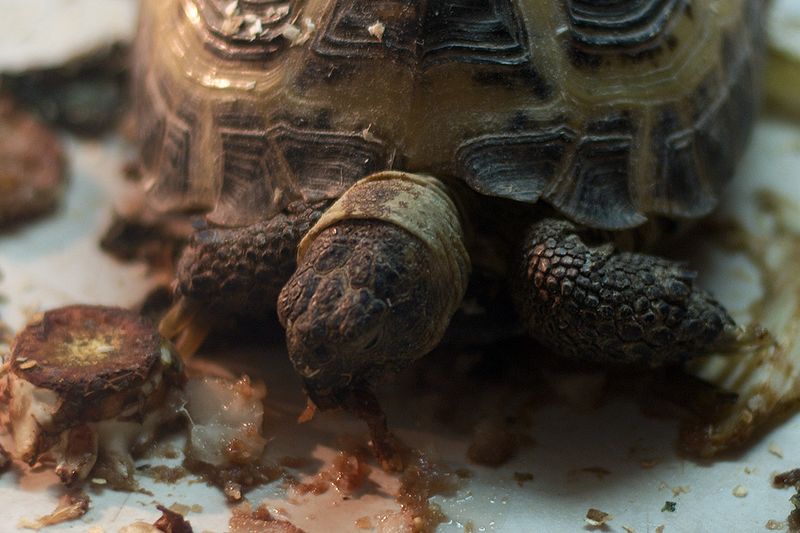 Grassland and desert species (i.e. Russian, Greek, Spurred and Pancake Tortoises) have evolved to consume a diet that is high in fiber and calcium and low in protein, fruit and fat. In the wild, grasses and herbaceous plants are their primary foods. Beans, dog food and other protein sources should be avoided, and fruit limited to an occasional treat. Honeysuckle, dandelion, clover and other native grasses, weeds and flowers can make up the bulk of the diet when available; please see this article http://blogs.thatpetplace.com/thatreptileblog/2009/07/29/tortoise-diets-mediterranean-species-and-russian-horsfield%E2%80%99s-tortoises/ for further information.The balance may consist of greens such as kale, endive, Swiss chard and romaine; avoid spinach and iceberg lettuce. Zoo Med’s Grassland Tortoise Diet http://www.thatpetplace.com/natural-grassland-tortoise-food may be added to salads. Hay (but not Timothy) should be provided to Spurred and Leopard Tortoises.
Grassland and desert species (i.e. Russian, Greek, Spurred and Pancake Tortoises) have evolved to consume a diet that is high in fiber and calcium and low in protein, fruit and fat. In the wild, grasses and herbaceous plants are their primary foods. Beans, dog food and other protein sources should be avoided, and fruit limited to an occasional treat. Honeysuckle, dandelion, clover and other native grasses, weeds and flowers can make up the bulk of the diet when available; please see this article http://blogs.thatpetplace.com/thatreptileblog/2009/07/29/tortoise-diets-mediterranean-species-and-russian-horsfield%E2%80%99s-tortoises/ for further information.The balance may consist of greens such as kale, endive, Swiss chard and romaine; avoid spinach and iceberg lettuce. Zoo Med’s Grassland Tortoise Diet http://www.thatpetplace.com/natural-grassland-tortoise-food may be added to salads. Hay (but not Timothy) should be provided to Spurred and Leopard Tortoises.
Rainforest Tortoises
Rainforest natives, such as African Hinge-backed, Yellow and Red-Footed Tortoises, require a diet rich in a wide variety of leafy greens, fruits, and vegetables. A small weekly meal of moist cat food, along with canned http://www.thatpetplace.com/pet-supplies-search#!Reptile-Supplies/reptile-food&ea_c=feeder-insects or live snails, earthworms and super mealworms, will satisfy their protein requirements.
Vitamin, Minerals and Water
 The calcium requirements of all tortoises appear to be quite high. Food should be powdered with Zoo Med ReptiCalcium with D3 or a similar product. A Vitamin/mineral supplement such as Reptivite with D3 should be used 2-3 times weekly.
The calcium requirements of all tortoises appear to be quite high. Food should be powdered with Zoo Med ReptiCalcium with D3 or a similar product. A Vitamin/mineral supplement such as Reptivite with D3 should be used 2-3 times weekly.
Water should be available, but damp conditions present a health hazard. A twice-weekly 15 minute soak should be provided if water bowls are routinely tipped, or if your tortoises seem not to be drinking regularly.
Other Feeding Considerations
High protein diets have been associated with “pyramiding” and other growth deformities in several species.
Adults can be fed 5-7 times weekly, juveniles daily.
Further Reading
NY Turtle & Tortoise Society Seminar (Galapagos Tortoises, others)
Turtle Conservancy Newsletter: Ploughshare Tortoises mating
Radiated Tortoise videos and info
Flat Tailed Tortoise image referenced from wikipedia and originally posted by Mark Pelligrini
Greek Tortoise image referenced from wikipedia and originally posted by Derek Coetzee
Yellow-footed Tortoise image referenced from wikipedia and originally posted by Geoff Gallice
 That Reptile Blog – Reptile, Amphibian and Exotic Pet Care and Information
That Reptile Blog – Reptile, Amphibian and Exotic Pet Care and Information

